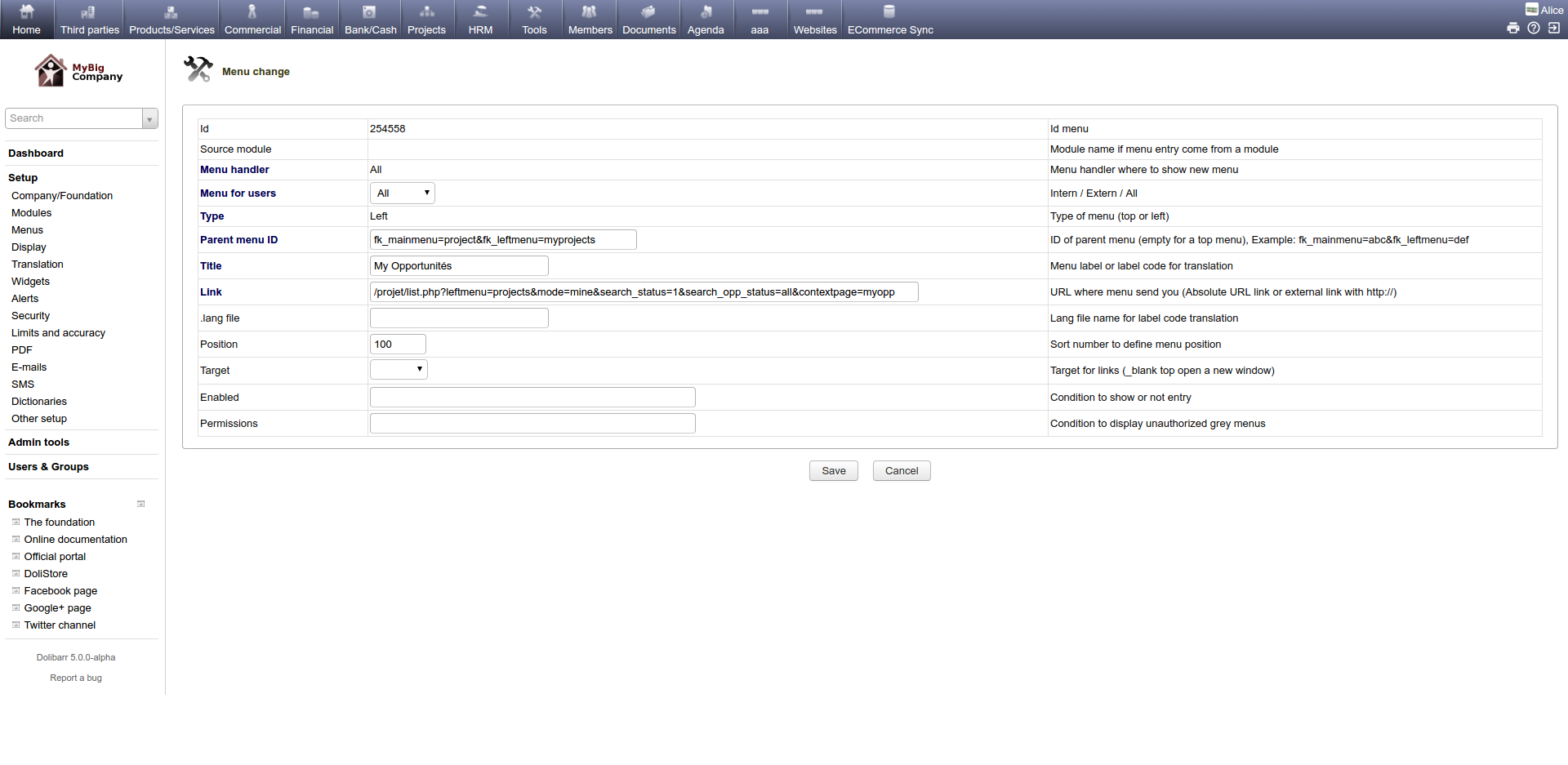Menus system
Dolibarr contains 2 systems to manage menus. One for desktop usage and one for smartphone. A menu system define which entry menu is visible, at which condition, and where (top, left)
Changing your menu manager with an existing one can be done from page Home -> Menus. Take the menu manager you want in the list.
If you want to personalize the menu, you can add you own menu entry or develop your own menu manager, that will replace completely the default one. You will decide how you store your menu definition (database like with the menu manager auguria, centralized hard coded menu entries like in the menu eldy, xml files, ...). Like you see, you can offer a menu manager with the behavior you need and the technology you want. See next chapters for that.
Imagine you want to add a new menu entry. Go on Home - Menus then choose Menu editor. Add an entry. For example to add a menu entry to switch to a page that list opportunities with filters already set, you will add and entry that will looks like this:
The aim of this paper is to describe how to create a new menu system in its entirety (to replace the entire menu entries, complete upheaval of the concept of navigation). This does not relate how to add menu entries. If you just want to know how to add menu entries within an existing menu manager, when developing an extension or a new module for example, you should look page Module development instead. If you want to completely replace a system menu with your own, the easiest way is to use the menu Manager "eldy_backoffice" as an example:
- Copy file htdocs/core/menus/standard/eldy_backoffice.php into a file with a name like htdocs/core/menus/standard/mymenu.php
- Edit this file mymenu.php. Function showmenu() of class MenuTop is the function called by Dolibarr, when generating a page, to show the top menu. You can put here the code you want, this function does not change any external variable and must show using "print" the menu to show. So you can get menu to show from a configuration file, a database and personalized it according to environment. Environment Dolibarr is stored into global variables: $user, $conf, $db, $langs, $mysoc, $hookmanager, $extrafields.
$user contains information about current user. $conf contains information about setup (activated modules, permissions, options, etc...) $langs contains information about active language.
Example of a function showmenu() into file htdocs/core/menus/standard/mymenu.php
function showmenu()
{
global $user, $conf, $langs;
global $dolibarr_main_db_name;
print '<table class="tmenu"><tr class="tmenu">';
// Menu Home
print '<td class="tmenu"><a '.$class.' href="'.DOL_URL_ROOT.'/index.php?mainmenu=home&leftmenu="'.($this->atarget?" target=".$this->atarget:"").'>'.$langs->trans("Home").'</a></td>';
// Put here other entries
// ...
print '</tr></table>';
}
Principle is same than for top menu.
- You must edit function showmenu() of class MenuLeft to build your left menu. If you want to show standard menu with just minor changes without redoing everything, you have to loop on content of array $menu->liste. If you want to build a menu completely different and controled only by yourself, you must, into the method showmenu(), create an object $newmenu=new Menu() and use methods $newmenu->add and $newmenu->add_submenu to defined list of left menu entries to show. Once this is done, you show those entries using some "print" to show content of array $newmenu->liste (that we have just defined) instead of printing content of $menu->liste.
Example of file htdocs/core/menus/standard/mymenu.php
function showmenu()
{
global $user,$conf,$langs,$dolibarr_main_db_name;
$newmenu = new Menu();
// Put here left menu entries
// ***** START *****
$langs->load("admin"); // Load translation file admin.lang
$newmenu->add(DOL_URL_ROOT."/admin/index.php?leftmenu=setup", $langs->trans("Setup"));
$newmenu->add_submenu(DOL_URL_ROOT."/admin/company.php", $langs->trans("MenuCompanySetup"));
$newmenu->add_submenu(DOL_URL_ROOT."/admin/modules.php", $langs->trans("Modules"));
$newmenu->add_submenu(DOL_URL_ROOT."/admin/ihm.php", $langs->trans("GUISetup"));
$newmenu->add_submenu(DOL_URL_ROOT."/admin/boxes.php", $langs->trans("Boxes"));
$newmenu->add_submenu(DOL_URL_ROOT."/admin/delais.php",$langs->trans("Alerts"));
$newmenu->add_submenu(DOL_URL_ROOT."/admin/triggers.php", $langs->trans("Triggers"));
$newmenu->add_submenu(DOL_URL_ROOT."/admin/perms.php", $langs->trans("Security"));
$newmenu->add_submenu(DOL_URL_ROOT."/admin/dict.php", $langs->trans("DictionnarySetup"));
$newmenu->add_submenu(DOL_URL_ROOT."/admin/const.php", $langs->trans("OtherSetup"));
// ***** END *****
// do not change code after this
// override menu_array by value array in $newmenu
$this->menu_array=$newmenu->liste;
$alt=0;
for ($i = 0 ; $i < sizeof($this->menu_array) ; $i++)
{
$alt++;
if ($this->menu_array[$i]['level']==0) {
if (($alt%2==0))
{
print '<div class="blockvmenuimpair">'."\n";
}
else
{
print '<div class="blockvmenupair">'."\n";
}
}
if ($this->menu_array[$i]['level']==0) {
if ($this->menu_array[$i]['enabled'])
print '<a class="vmenu" href="'.$this->menu_array[$i]['url'].'">'.$this->menu_array[$i]['titre'].'</a><br>';
else
print '<font class="vmenudisabled">'.$this->menu_array[$i]['titre'].'</font><br>';
}
if ($this->menu_array[$i]['level']==1) {
if ($this->menu_array[$i]['enabled'])
print '<a class="vsmenu" href="'.$this->menu_array[$i]['url'].'">'.$this->menu_array[$i]['titre'].'</a><br>';
else
print '<font class="vsmenudisabled">'.$this->menu_array[$i]['titre'].'</font><br>';
}
if ($this->menu_array[$i]['level']==2) {
if ($this->menu_array[$i]['enabled'])
print ' <a class="vsmenu" href="'.$this->menu_array[$i]['url'].'">'.$this->menu_array[$i]['titre'].'</a><br>';
else
print ' <font class="vsmenudisabled">'.$this->menu_array[$i]['titre'].'</font><br>';
}
if ($this->menu_array[$i]['level']==3) {
if ($this->menu_array[$i]['enabled'])
print ' <a class="vsmenu" href="'.$this->menu_array[$i]['url'].'">'.$this->menu_array[$i]['titre'].'</a><br>';
else
print ' <font class="vsmenudisabled">'.$this->menu_array[$i]['titre'].'</font><br>';
}
if ($i == (sizeof($this->menu_array)-1) || $this->menu_array[$i+1]['level']==0) {
print "</div>\n";
}
}
}
You can force usage of your own menu manager by creating a module. For this , all you have to do is to declare the 4 following constants into the array $this->const of your module descriptor file (See page Module development).
* 1=>array('MAIN_MENU_STANDARD_FORCED','chaine','mymodule.php','Force menu handler to this value',1,'current',1),
* 2=>array('MAIN_MENUFRONT_STANDARD_FORCED','chaine','mymodule.php','Force menu handler to this value',1,'current',1),
* 3=>array('MAIN_MENU_SMARTPHONE_FORCED','chaine','mymodule.php','Force menu handler to this value',1,'current',1),
* 4=>array('MAIN_MENUFRONT_SMARTPHONE_FORCED','chaine','mymodule.php','Force menu handler to this value',1,'current',1),
Your menu manager will be used once the module is activated.
